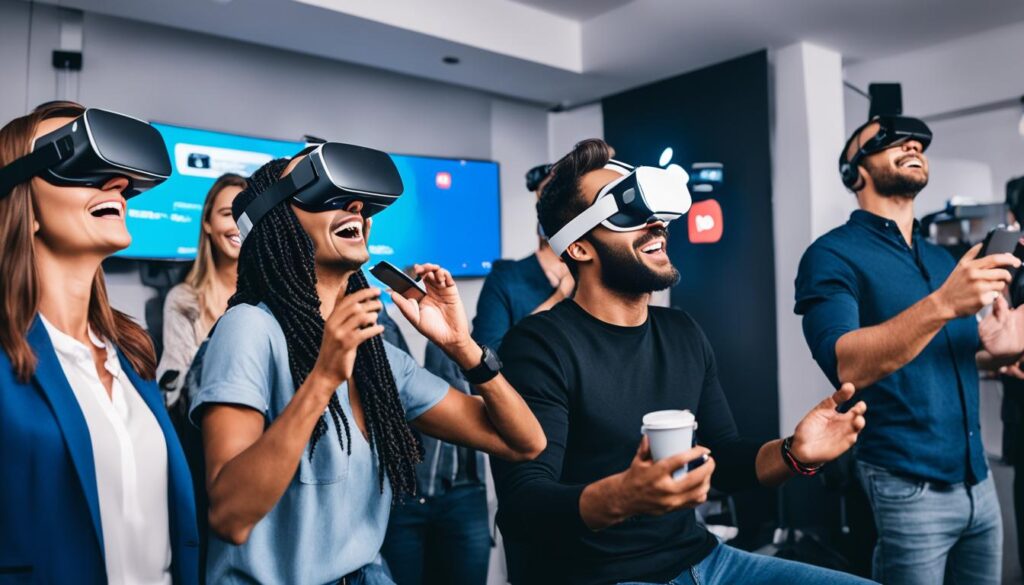Blog
2024 Social Media Trends: Stay Ahead of the Curve
The ever-evolving landscape of social media presents new opportunities and challenges for brands in 2024. To navigate this dynamic environment successfully, it’s crucial to stay informed about the latest social media trends. From strategic social media marketing to effective social media management, understanding the current landscape and embracing emerging trends can give your brand a competitive edge.
In this article, we will explore the top social media trends for 2024 and provide insights on how to leverage them for success. From the growing influence of AI in customer support and image editing to the dominance of platforms like TikTok and Instagram Reels, we will uncover the strategies that can help your brand achieve higher ROI. We will also delve into the importance of entertainment, authenticity, nano-influencers, user-generated content, storytelling, stronger communities, social listening, and highly personalized ad content.
By embracing these impactful social media trends, you can optimize your social media strategy, engage your audience, and drive your brand’s success in 2024.
Key Takeaways:
- Stay ahead of the curve by embracing the latest social media trends for 2024.
- AI is shaping social media strategies, with brands doubling their use of AI in customer support and image editing.
- Focus on your top-performing platforms, such as TikTok and Instagram Reels, to achieve higher ROI.
- Entertainment is a key factor in social media success, and authenticity is valued by consumers.
- Nano-influencers are gaining influence, and user-generated content plays a significant role in building brand credibility.
The AI Trend: Redefining Authenticity in Social Media Trends
The AI Trend is revolutionizing social media strategies in 2024 as brands eagerly adopt the use of artificial intelligence (AI). Organizations are planning to leverage AI for customer support activities, aiming for a significant increase of 318%. Additionally, the integration of AI in image editing is set to rise by 260% this year.
While social marketers are enthusiastic about the potential of AI, audience acceptance of AI-generated content remains varied. Different generations exhibit differing levels of trust when it comes to AI-generated content, with Gen Z demonstrating a heightened inclination to trust and engage with AI content compared to baby boomers.
To succeed in 2024, brands must redefine authenticity and shift their focus towards delivering exceptional brand experiences, irrespective of whether the content is created exclusively by humans or by AI. Understanding the audience’s perception of AI is crucial, allowing brands to tailor their content accordingly, ensuring it resonates with their target audience.
The Platform Trend: Focusing on Top-Performing Channels
The Platform Trend in 2024 highlights the importance of strategic brand focus on their top-performing social media platforms. As the average social media user engages with approximately seven platforms each month, maintaining a presence on multiple networks has become a challenge for brands. The concern of Return on Investment (ROI) in being on multiple platforms is a major consideration for organizations, with time/budget constraints, uncertainty in success metrics, and attribution uncertainty being the top contributing factors. To address these challenges, brands are now prioritizing their platform-by-platform ROI scores and making informed decisions to abandon platforms that fail to meet their ROI criteria.
This trend is fueled by the need to tailor social content to the unique audiences and specifications of each platform. Different platforms have distinct audience demographics, content preferences, and social media engagement behaviors. By focusing on the top-performing platforms, brands can allocate their resources more effectively and optimize their social media presence to reach the right audience with impactful content. It also allows brands to concentrate their efforts on platforms where they have a higher probability of achieving better ROI.
The constantly evolving nature of social media platforms adds to the challenge of maintaining a strong presence across multiple channels. Each platform introduces new features, algorithm updates, and user interface changes that can significantly impact a brand’s performance. By narrowing their focus to top-performing platforms, brands can dedicate the necessary time and resources to understand and adapt to the specific requirements of those platforms, ensuring better-quality content and improved engagement.
The Impact of the Platform Trend on Businesses
The Platform Trend has significant implications for businesses. By strategically selecting their social media platforms, brands can overcome the challenges of managing multiple networks and maximize their ROI. This focused approach allows businesses to:
- Allocate resources more effectively and efficiently
- Generate higher engagement and conversions through tailored content
- Improve brand visibility and reach targeted audiences
- Enhance brand consistency and messaging
- Adapt to platform-specific features and algorithm changes
Example of Platform Prioritization and ROI Assessment
| Platform | Monthly Active Users | Average Engagement Rate | ROI Score |
|---|---|---|---|
| 1 billion | 6% | 9.2 | |
| TikTok | 700 million | 12% | 8.8 |
| 330 million | 5% | 6.5 | |
| 740 million | 3% | 4.6 |
The table above illustrates an example of how a brand can assess platforms based on key metrics such as monthly active users, average engagement rate, and ROI score. By evaluating these factors, brands can prioritize platforms like Instagram and TikTok, which demonstrate high engagement rates and strong ROI scores. This approach allows brands to streamline their social media efforts and maximize their impact on platforms that offer the greatest potential for achieving business goals.
The ROI Trend: Entertainment as a Fuel for Social ROI
The ROI Trend in 2024 focuses on the importance of entertainment in achieving social media ROI. Social media platforms are no longer just for staying connected; they serve as a means for consumers to be entertained and unwind. To effectively engage their audience, brands need to shift their focus from self-promotion to providing entertaining and relatable content.
Consumers have grown weary of self-promotion and are drawn to authentic and relatable content. Despite this shift in consumer preferences, many marketers continue to bombard their audience with multiple product or brand updates each week, failing to align their content with what people actually want to see.
The challenge lies in demonstrating ROI through engagement metrics when the content being promoted is not what the audience desires. Brands must find innovative ways to measure and demonstrate ROI beyond just engagement metrics to accurately reflect the impact of their social media efforts.
The Disconnect Between Brands and Consumer Preferences
According to consumer preferences, entertainment takes precedence over self-promotion on social media platforms. However, brands often struggle to adapt their strategies to align with these preferences. Consider the following statistics:
| Issue | Statistics |
|---|---|
| Consumer preference for entertainment | More than 60% of social media users expect entertaining content on their feeds. |
| Frequency of product or brand updates | 65% of marketers still publish product or brand updates multiple times a week. |
These statistics highlight the gap between what brands post and what people actually want to see. To bridge this disconnect, brands must prioritize authenticity, relatability, and entertainment in their social media content.
Demonstrating ROI Through Innovative Metrics
Engagement metrics are essential for measuring social media ROI. However, they may not fully capture the value of entertaining content that aligns with consumer preferences. To demonstrate the true impact of their social media efforts, brands should consider innovative metrics that go beyond engagement. These metrics may include:
- Reach and impressions: Assess the number of unique users who view the content and the overall visibility of the brand.
- Conversions and sales: Measure the number of conversions and sales generated through social media campaigns.
- Brand sentiment: Analyze the sentiment of social media conversations surrounding the brand to gauge audience perception.
By measuring these innovative metrics, brands can accurately demonstrate the ROI achieved through their entertaining and consumer-focused social media content.


Short-Form Video: The Dominant Content Format
Short-form video has emerged as the dominant content format in 2024, revolutionizing the way people consume digital content. Leading the way are popular platforms such as TikTok and Instagram Reels, which have captured the attention of millions.
Consumers are increasingly gravitating towards short videos due to their compact format and rapid delivery of messages. Studies indicate that short-form videos are particularly favored when searching for products or services, with Generation Z embracing this format with enthusiasm.
Marketers have recognized the tremendous potential of short-form videos in capturing audience attention and plan to allocate more resources to creating compelling content in this format. The concise nature of short-form videos requires precision in storytelling and demands engaging visuals to captivate viewers.
A notable trend emerging alongside the popularity of short-form videos is the rise of user-generated content. This type of content creation aligns with the brief and captivating nature of short videos, making it more accessible for individuals to contribute their unique perspectives and creativity. User-generated content not only adds authenticity and diversity to brand messages but also fosters a stronger sense of community and encourages active audience participation.
The Power of Short-Form Videos
“Short-form videos have revolutionized the way content is consumed, offering a small window of opportunity for brands to captivate their audience and convey impactful messages.” – Digital Marketing Expert
The power of short-form videos lies in their ability to instantly grab attention and make a lasting impression. Studies have shown that consumers have shorter attention spans and appreciate content that can deliver the intended message quickly and effectively. Short videos achieve this by condensing information into easily digestible bites, making them ideal for capturing and retaining audience interest.
The Rise of User-Generated Content
“User-generated content injects an authentic and relatable element into brand communication, fostering stronger connections with audiences and building trust.” – Social Media Strategist
User-generated content has become an integral part of the short-form video trend, enabling brands to leverage the creativity and unique perspectives of their audience. The collaborative nature of user-generated content not only builds a sense of trust and credibility but also encourages active engagement and participation from the audience. Brands that embrace user-generated content can tap into the creativity and passion of their customers, resulting in a more diverse and inclusive brand image.
The Impact on Content Consumption
The dominance of short-form videos has also influenced the way audiences consume content. With the rise of mobile devices and limited attention spans, consumers are now more likely to seek out bite-sized content that can be consumed quickly and easily on-the-go. Brands that adapt to this new content consumption pattern by creating captivating short videos stand to gain a competitive edge and effectively connect with their target audience.
| Benefits of Short-Form Video | Embracing User-Generated Content | Impact on Content Consumption |
|---|---|---|
| 1. Captures attention in a short span of time | 1. Adds authenticity and relatability | 1. Fits into shorter attention spans |
| 2. Delivers messages quickly and effectively | 2. Fosters audience engagement and participation | 2. Provides on-the-go content consumption |
| 3. Enables concise and impactful storytelling | 3. Encourages brand community and collaboration | 3. Appeals to Gen Z and younger audiences |
| 4. Showcases visual creativity and innovation | 4. Enhances trust and credibility | 4. Drives higher engagement rates |
Authenticity: Building Trust and Loyalty
Authenticity is a key trend in 2024 as consumers increasingly prioritize accurate and trustworthy content over polished social media advertising. To build trust and loyalty, brands must shift their focus towards sharing genuine experiences, stories, and behind-the-scenes insights.
By humanizing themselves and prioritizing transparency, brands can foster meaningful relationships with their consumers. This requires rethinking marketing tactics to deliver content that resonates with their target audience and connects deeply on a personal level.
Transparency plays a crucial role in building trust for your social media content strategy. The more transparent and honest a brand is, the more respect and trust it gains from its audience. Consumers appreciate brands that openly share information and provide an authentic look into their operations.
Storytelling is an effective way to showcase authenticity and establish a genuine connection with consumers. By crafting compelling narratives, brands can establish an emotional bond and create a memorable brand experience.
Authenticity not only connects deeply with audiences but also enhances business credibility.
For brands, it’s essential to consistently deliver on their promises and values. Being true to their identity and purpose helps build a strong foundation of trust, which in turn fuels customer loyalty and advocacy.
To emphasize the importance of authenticity, brands can highlight their core values, display social responsibility, and actively engage with their audience. By openly addressing any mistakes or challenges, brands can showcase their commitment to transparency and accountability.
In summary, authenticity is a vital trend in 2024 that demands brands to prioritize trust-building through genuine experiences, storytelling, and transparency. By staying true to their values and purpose, brands can forge deep connections with their audience and establish a strong brand identity.
The Rise of Nano-Influencers
Nano-influencers, with fewer than 1,000 followers, are emerging as a potent force in influencer marketing in 2024. They foster closer connections and trust with their smaller follower base, resulting in higher engagement rates compared to larger influencers. Micro-influencers, slightly more popular than nano-influencers, can generate up to 60% more engagement than macro-influencers. This trend highlights the increasing effectiveness and influence of smaller content creators in marketing strategies. Collaborating with nano-influencers also offers cost benefits, as their smaller scale results in reduced costs compared to more prominent influencers. Brands should consider leveraging the power of nano-influencers to achieve higher engagement and cost-effective marketing strategies.


To further highlight the impact of nano-influencers, let’s look at a comparison:
| Types of Influencers | Average Number of Followers | Engagement Rate |
|---|---|---|
| Nano-Influencers | Less than 1,000 | High |
| Micro-Influencers | 1,000 – 10,000 | Higher than macro-influencers |
| Macro-Influencers | 10,000+ | Lower than micro-influencers |
As shown in the table above, nano-influencers with their smaller follower base can offer remarkable engagement rates, making them a valuable asset for brands. Additionally, collaborating with these influencers can be more cost-effective compared to larger influencers.
User-Generated Content: Building Brand Credibility
User-generated content (UGC) plays a significant role in strengthening brand credibility and engagement in 2024. Consumers expect brands to integrate UGC across their digital and physical touchpoints, including reviews, social media posts, and images featuring products or services. This form of content thrives on its authenticity and relatability, building trust between a brand and its consumers.
UGC allows consumers to become active participants in shaping a brand’s image and reputation. When users share their experiences and opinions, it adds a layer of credibility that traditional marketing cannot replicate. By incorporating UGC into their brand strategy, companies demonstrate that they value their customers’ voices and perspectives.
Brands and retailers are recognizing the power of UGC and are shifting or considering reallocating their paid media budgets towards owned and earned content creation. This strategic move allows them to leverage the authenticity and positive sentiment generated by UGC to improve brand awareness, extend reach, and increase conversion rates.
UGC helps create a sense of community and fosters deeper connections between a brand and its audience. By featuring content created by their customers, brands show that they value and listen to their customers, thus building trust and loyalty.
Brands should encourage and incorporate user-generated content to enhance their brand credibility. Embracing UGC can be achieved through various methods, such as running UGC contests, incentivizing customers to share their experiences, and actively engaging with user-generated content on social media platforms. By making UGC an integral part of their marketing strategy, brands can not only establish credibility but also create a stronger bond with their target audience.
Benefits of User-Generated Content
By leveraging user-generated content, brands can enjoy numerous benefits:
- Increase brand credibility: UGC provides social proof, showing potential customers that real people trust and endorse the brand.
- Enhance engagement: UGC creates opportunities for customers to actively engage with the brand, elevating their overall experience.
- Extend reach: UGC often reaches wider audiences through organic sharing and social media algorithms.
- Boost conversions: UGC has a positive impact on conversion rates as consumers are more likely to trust the opinions and experiences of fellow customers.
Incorporating user-generated content is an effective way for brands to build trust, credibility, and consumer loyalty. By leveraging the authentic and relatable content created by their customers, brands can strengthen their position in the market and forge meaningful connections that drive long-term success.


| Statistics on User-Generated Content | Importance of UGC |
|---|---|
| 85% of consumers perceive UGC as more trustworthy than branded content. | UGC builds brand credibility through authentic and relatable experiences shared by real customers. |
| UGC-based ads see a 4x higher click-through rate compared to non-UGC ads. | UGC resonates with consumers, leading to higher engagement and increased ad effectiveness. |
| 92% of consumers trust recommendations from friends and family over traditional advertising. | UGC reflects the opinions and experiences of real people, similar to recommendations from friends and family. |
These statistics highlight the significance of user-generated content in building brand credibility, reinforcing consumer trust, and driving business growth. By prioritizing UGC, brands can tap into the power of real customer experiences and build stronger connections with their audience.
Storytelling: Forging Emotional Connections
Storytelling has emerged as a prominent trend in marketing strategies for 2024. Brands have recognized its power to create emotional connections by weaving compelling narratives around their products or brand stories. Personalized content and a human-first messaging approach are integral to effective storytelling.
Marketing decision-makers have acknowledged the significance of personal, human-first messaging in crafting engaging stories. By prioritizing this approach, brands can differentiate themselves from competitors, enhance message retention, and humanize their brand in the eyes of the audience.
“Storytelling allows brands to tap into the emotions of their audience, creating a lasting impact and fostering deep connections.”
In an era where consumers value emotional connections, storytelling has become a cornerstone of effective marketing strategies. It goes beyond delivering information or promoting products; it aims to evoke genuine emotions and resonate with the audience on a personal level.
By leveraging storytelling techniques, brands can captivate their target audience, leaving a lasting impression and building trust. A well-crafted story engages the audience’s emotions, creating a sense of authenticity, relatability, and familiarity.
Table: Elements of Effective Storytelling
| Elements | Description |
|---|---|
| Compelling Narrative | Crafting a story that captures the attention and interest of the audience. |
| Emotional Appeal | Eliciting emotions such as joy, empathy, inspiration, or nostalgia. |
| Personalization | Tailoring the story to resonate with the unique experiences and interests of the audience. |
| Human-first Approach | Putting the audience at the center of the story, focusing on their needs, desires, and aspirations. |
| Authenticity | Delivering a genuine and transparent message that aligns with the brand’s values and identity. |
Whether through text, images, or videos, storytelling allows brands to connect with their audience holistically. It creates an emotional bond that transcends transactional relationships, fostering loyalty and advocacy.
“Powerful storytelling moves beyond selling products; it leaves a lasting impression in the hearts and minds of the audience.”


Storytelling is a potent tool for brands seeking to build long-term relationships with their customers. By investing in personalized, emotion-driven narratives, brands can forge deep connections and stand out in today’s competitive marketplace.
Stronger, Smaller Communities: Nurturing Connections
As social media continues to evolve, a prominent trend in 2024 is the emergence of stronger, smaller communities. People are increasingly using social platforms to connect with others who share their interests, forming niche audience groups that foster enriched interaction, open dialogue, and personalized experiences for their members.
Brands have recognized the power of these communities and are leveraging their potential by catering to their unique needs and fostering a sense of belonging. By actively engaging with community members, brands can build stronger relationships, improve customer retention, and benefit from word-of-mouth marketing.
Channels like private forums, social media platforms, webinars, and live events offer opportunities for brands to communicate directly with these communities and address their specific interests and concerns. This personalized approach not only strengthens brand-consumer relationships but also allows brands to gain valuable insights and feedback from their target audience.
To illustrate the impact of stronger, smaller communities, consider the example below:
Example:
A gaming company, XYZ Gaming, understands the importance of nurturing smaller communities within their customer base. They create private forums where gamers can connect with fellow enthusiasts, share gameplay experiences, and discuss upcoming releases. XYZ Gaming also hosts live tournaments and webinars, providing a platform for gamers to showcase their skills and engage with industry professionals. By fostering these stronger, smaller communities, XYZ Gaming has built a loyal and passionate customer base, leading to increased brand advocacy and organic growth.
Nurturing stronger, smaller communities is a highly effective strategy for brands aiming to create personalized experiences, foster brand loyalty, and establish a solid foundation for growth in the highly competitive social media landscape of 2024.
Social Listening: Understanding Customer Sentiments
Social listening is a crucial trend in 2024, as brands leverage it to gain valuable insights into customer sentiments, emerging trends, and competitor strategies. Unlike simply tracking likes and comments, social listening involves actively monitoring and analyzing conversations across various platforms.
By employing social listening, brands can refine their marketing strategies, enhance customer service, and innovate their product offerings based on direct customer feedback. It also allows brands to identify potential crises and negative sentiments early on, enabling them to take proactive measures and mitigate any damaging impacts.
Actively listening to their target audience empowers brands to stay ahead of the curve. They can pinpoint emerging trends and adjust their strategies accordingly, ensuring they remain relevant and appealing to their customers. Moreover, social listening fosters improved customer relationships by demonstrating that brands genuinely care about their customers and heed their opinions and preferences.
To illustrate the significance of social listening, here is an example based on a fictional haircare brand:
“By actively listening to social media conversations, our haircare brand identified a growing trend among customers for sustainable and eco-friendly haircare products. Through social listening, we gained insights into the language and topics discussed by our target audience, allowing us to develop a new line of environmentally conscious hair products. As a result, we achieved a 30% increase in customer satisfaction and loyalty, positively impacting our bottom line.”
The example above showcases how social listening enables brands to make informed decisions and tailor their offerings to meet customer demands effectively.
| Benefits of Social Listening |
|---|
| 1. Understand customer sentiments |
| 2. Gain insights into emerging trends |
| 3. Analyze competitor strategies |
| 4. Refine marketing strategies |
| 5. Improve customer service |
| 6. Innovate product offerings |
| 7. Identify potential crises early |
By harnessing the power of social listening, brands can unlock a treasure trove of customer insights and stay one step ahead of their competitors, while also forging stronger connections with their target audience.
Conclusion
Embracing the latest social media trends is crucial for staying ahead of the curve in 2024. The AI Trend, Platform Trend, and ROI Trend are among the key factors shaping social media strategies. To succeed, brands must redefine authenticity, focus on their top-performing platforms, and prioritize entertainment for maximum social ROI.
Short-form video, authenticity, nano-social media influencers, user-generated content, storytelling, stronger communities, social listening, highly personalized ad content, and user-focused social media algorithms are other important trends to consider. By understanding and leveraging these trends, brands can enhance their social media marketing strategies and outpace the competition.
Staying ahead in the ever-evolving social media landscape requires a comprehensive social media strategy that embraces these trends. By adapting to the changing preferences of social media users, brands can build stronger connections, increase engagement, and drive their business forward in 2024 and beyond.
FAQ
What are the top social media trends for 2024?
The top social media trends for 2024 include the AI Trend, Platform Trend, and ROI Trend. Brands are focusing on AI in customer support and image editing, prioritizing their top-performing platforms, and leveraging entertainment for higher ROI.
How is AI shaping social media strategies in 2024?
Brands are planning to increase their use of AI in customer support activities by 318% and for editing images by 260% in 2024. However, audiences have varying levels of trust towards AI-generated content, so brands need to redefine authenticity and tailor content accordingly.
What is the Platform Trend in 2024?
The Platform Trend in 2024 is about strategic brands focusing on their top-performing social media platforms. Brands are prioritizing their own platform-by-platform ROI scores and making decisions to abandon platforms that aren’t meeting their ROI criteria.
How does entertainment impact social media ROI in 2024?
Entertainment is a crucial factor in achieving social media ROI in 2024. Brands need to shift their focus from self-promotion to providing entertaining and relatable content that resonates with their audience. Self-promotion is seen as a major turn-off, and brands should prioritize authenticity and relatability in their content.
What is the dominant content format in 2024?
Short-form video is the dominant content format in 2024, with platforms like TikTok and Instagram Reels leading the way. Short videos have become the preferred method of consuming content, and marketers are recognizing the effectiveness of short-form videos and increasing their budget for creating such content.
Why is authenticity important in social media marketing?
Authenticity is important in social media marketing because consumers value accurate and trustworthy content over polished advertising. Brands need to focus on building trust and loyalty by sharing genuine experiences, stories, and behind-the-scenes insights.
What are nano-influencers and why are they significant in 2024?
Nano-influencers, with fewer than 1,000 followers, are emerging as a potent force in influencer marketing in 2024. They foster closer connections and trust with their smaller follower base, resulting in higher engagement rates compared to larger influencers. Brands can leverage the power of nano-influencers for higher engagement and cost-effective marketing strategies.
How does user-generated content strengthen brand credibility in 2024?
User-generated content (UGC) plays a significant role in strengthening brand credibility and engagement in 2024. Consumers expect brands to integrate UGC across their digital and physical touchpoints, including reviews, social media posts, and images featuring products or services.
Why is storytelling important in marketing strategies?
Storytelling has come to the forefront of marketing strategies in 2024. By weaving a compelling narrative around a brand or its product, brands can forge emotional connections with the audience. This personal, human-first approach differentiates brands, enhances message retention, and humanizes the brand.
How can brands benefit from stronger, smaller communities on social media?
Stronger, smaller communities are on the rise in 2024, offering enriched interaction, open dialogue, and personalized experiences. Brands can leverage the power of these communities by catering to their unique needs and fostering a sense of belonging, resulting in stronger relationships, improved customer retention, and word-of-mouth marketing.
What is social listening and why is it important in 2024?
Social listening is the act of monitoring digital conversations to understand customer sentiments, gain insights into emerging trends, and analyze competitor tactics. It helps brands refine their marketing strategies, improve customer service, and innovate their product offerings based on direct customer feedback.
How can brands stay ahead of the curve in 2024?
Brands can stay ahead of the curve in 2024 by embracing the latest social media trends, including AI, focusing on top-performing platforms, prioritizing entertainment, leveraging short-form videos, emphasizing authenticity, collaborating with nano-influencers, incorporating user-generated content, utilizing storytelling, nurturing stronger communities, and actively practicing social listening.



